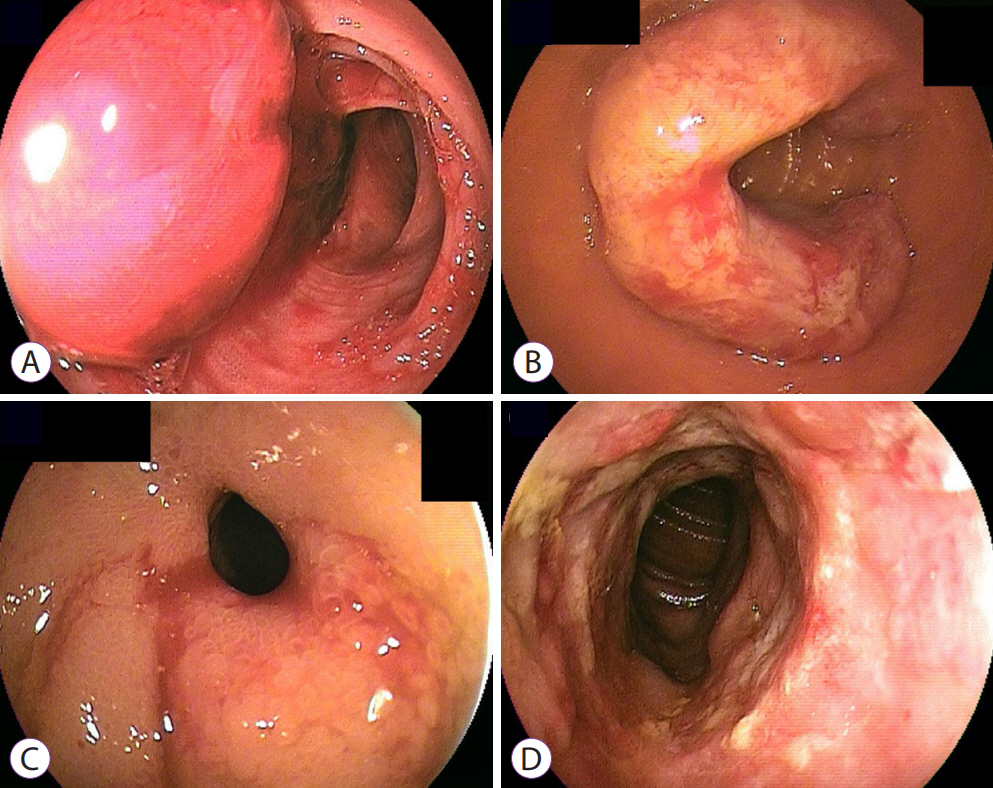Clin Endosc.
2021 Jan;54(1):85-91. 10.5946/ce.2020.047.
Clinicopathological Features of Small Bowel Tumors Diagnosed by Video Capsule Endoscopy and Balloon-Assisted Enteroscopy: A Single Center Experience
- Affiliations
-
- 1Division of Gastroenterology, Department of Internal Medicine, Korea University Guro Hospital, Korea University, College of Medicine, Seoul, Korea
- KMID: 2512312
- DOI: http://doi.org/10.5946/ce.2020.047
Abstract
- Background/Aims
Small bowel malignancies often present a diagnostic challenge due to their relative rarity and nonspecific clinical symptoms. However, technical developments in endoscopic instruments, including video capsule endoscopy (VCE) and enteroscopy, have allowed for the visualization of the entire small bowel. This study aimed to investigate the clinicopathological features of small bowel malignant tumors diagnosed by VCE and double-balloon enteroscopy (DBE) in a single tertiary center.
Methods
We retrospectively analyzed VCE and DBE findings from Korea University Guro Hospital from January 2010 through September 2018.
Results
A total of 510 VCE and 126 DBE examinations were performed in 478 patients. Small bowel malignancies were diagnosed in 28 patients (15 males; mean age, 61.0 years; range, 42 to 81 years). Among them, 8 had lymphoma, 8 had primary adenocarcinoma, 7 had gastrointestinal stromal tumor (GIST) and 5 had metastatic cancer. Abdominal pain and obstructive symptoms were the most common findings in metastatic cancers (4/5, 80%). On the other hand, obscure gastrointestinal bleeding was the most common symptom of GIST (6/7, 85.7%) and adenocarcinoma (3/8, 37.5%).
Conclusions
Approximately 6% of the patients who underwent either VCE or DBE were diagnosed with small bowel malignancy. These findings demonstrated the different clinical characteristics among small bowel malignancies and merit further study.
Keyword
Figure
Reference
-
1. de Franchis R, Rondonotti E, Abbiati C, Beccari G, Signorelli C. Small bowel malignancy. Gastrointest Endosc Clin N Am. 2004; 14:139–148.
Article2. Pan SY, Morrison H. Epidemiology of cancer of the small intestine. World J Gastrointest Oncol. 2011; 3:33–42.
Article3. Schottenfeld D, Beebe-Dimmer JL, Vigneau FD. The epidemiology and pathogenesis of neoplasia in the small intestine. Ann Epidemiol. 2009; 19:58–69.
Article4. Schwartz GD, Barkin JS. Small bowel tumors. Gastrointest Endosc Clin N Am. 2006; 16:267–275.
Article5. Cangemi DJ, Patel MK, Gomez V, Cangemi JR, Stark ME, Lukens FJ. Small bowel tumors discovered during double-balloon enteroscopy: analysis of a large prospectively collected single-center database. J Clin Gastroenterol. 2013; 47:769–772.6. Cobrin GM, Pittman RH, Lewis BS. Increased diagnostic yield of small bowel tumors with capsule endoscopy. Cancer. 2006; 107:22–27.
Article7. Kim JH, Moon W. Optimal diagnostic approaches for patients with suspected small bowel disease. Clin Endosc. 2016; 49:364–369.
Article8. Lee BI, Choi H, Choi KY, et al. Clinical characteristics of small bowel tumors diagnosed by double-balloon endoscopy: KASID multi-center study. Dig Dis Sci. 2011; 56:2920–2927.
Article9. Postgate A, Despott E, Burling D, et al. Significant small-bowel lesions detected by alternative diagnostic modalities after negative capsule endoscopy. Gastrointest Endosc. 2008; 68:1209–1214.
Article10. Ross A, Mehdizadeh S, Tokar J, et al. Double balloon enteroscopy detects small bowel mass lesions missed by capsule endoscopy. Dig Dis Sci. 2008; 53:2140–2143.
Article11. Urbain D, De Looze D, Demedts I, et al. Video capsule endoscopy in small-bowel malignancy: a multicenter Belgian study. Endoscopy. 2006; 38:408–411.
Article12. Yen HH, Chang CW, Chou JW, Wei SC. Balloon-assisted enteroscopy and capsule endoscopy in suspected small bowel Crohn’s disease. Clin Endosc. 2017; 50:417–423.
Article13. Hosoe N, Takabayashi K, Ogata H, Kanai T. Capsule endoscopy for small-intestinal disorders: current status. Dig Endosc. 2019; 31:498–507.
Article14. Valero M, Bravo-Velez G, Oleas R, et al. Capsule endoscopy in refractory diarrhea-predominant irritable bowel syndrome and functional abdominal pain. Clin Endosc. 2018; 51:570–575.
Article15. Chung CS, Tai CM, Huang TY, et al. Small bowel tumors: a digestive endoscopy society of Taiwan (DEST) multicenter enteroscopy-based epidemiologic study. J Formos Med Assoc. 2018; 117:705–710.
Article16. Hermans C, Stronkhorst A, Tjhie-Wensing A, et al. Double-balloon endoscopy in overt and occult small bowel bleeding: results, complications, and correlation with prior videocapsule endoscopy in a tertiary referral center. Clin Endosc. 2017; 50:69–75.
Article17. Kim J. Training in endoscopy: enteroscopy. Clin Endosc. 2017; 50:328–333.
Article18. Guo X, Mao Z, Su D, Jiang Z, Bai L. The clinical pathological features, diagnosis, treatment and prognosis of small intestine primary malignant tumors. Med Oncol. 2014; 31:913.
Article19. Kim CH, Kye BH, Lee JI, et al. Clinicopathological features of primary jejunoileal tumors. J Korean Soc Coloproctol. 2010; 26:334–338.
Article20. Yang YS, Huang QY, Wang WF, Sun G, Peng LH. Primary jejunoileal neoplasmas: a review of 60 cases. World J Gastroenterol. 2003; 9:862–864.
Article21. Yamamoto H, Ogata H, Matsumoto T, et al. Clinical practice guideline for enteroscopy. Dig Endosc. 2017; 29:519–546.
Article22. Horie T, Hosoe N, Takabayashi K, et al. Endoscopic characteristics of small intestinal malignant tumors observed by balloon-assisted enteroscopy. World J Gastrointest Endosc. 2019; 11:373–382.
Article23. Chen EY, Vaccaro GM. Small bowel adenocarcinoma. Clin Colon Rectal Surg. 2018; 31:267–277.
Article24. Mocellin S, Nitti D. Gastrointestinal carcinoid: epidemiological and survival evidence from a large population-based study (n = 25 531). Ann Oncol. 2013; 24:3040–3044.
Article
- Full Text Links
- Actions
-
Cited
- CITED
-
- Close
- Share
- Similar articles
-
- Diagnostic and Therapeutic Capability of Double-Balloon Enteroscopy in Clinical Practice
- Recent developments in small bowel endoscopy: the “black box” is now open!
- Roles of Capsule Endoscopy and Balloon-Assisted Enteroscopy in the Optimal Management of Small Bowel Bleeding
- Roles of Capsule Endoscopy and Device-Assisted Enteroscopy in the Diagnosis and Treatment of Small-Bowel Tumors
- Balloon-Assisted Enteroscopy and Capsule Endoscopy in Suspected Small Bowel Crohn's Disease



